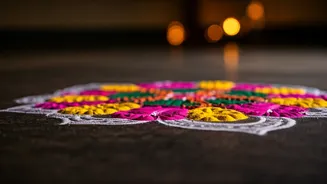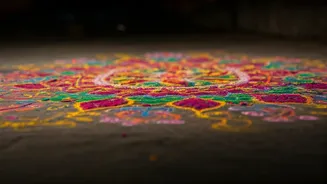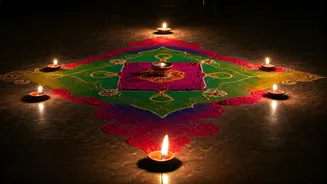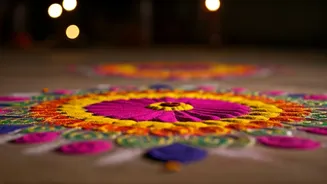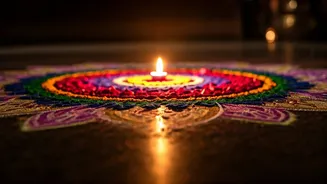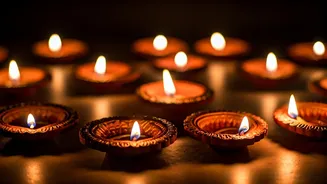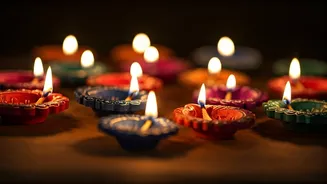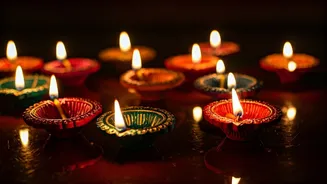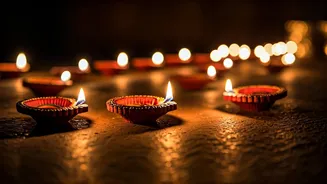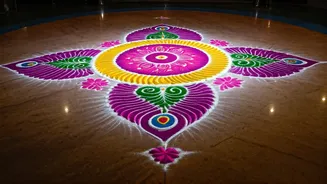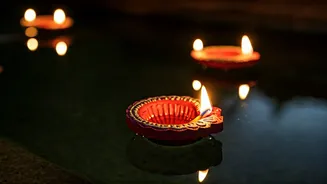Tradition and Artistry
Rangoli, an art form deeply ingrained in Indian culture, is a visual representation of the festive spirit, particularly during Diwali. Creating Rangoli designs
is a tradition that brings families together, with each design carrying its unique significance and charm. The art itself is a way to express creativity and welcome prosperity and good fortune into the home. Traditionally, Rangoli designs incorporate vibrant colors, patterns, and motifs that reflect cultural heritage and beliefs. The preparation and execution of Rangoli often involves family participation, making it a communal activity that strengthens bonds. From simple geometric shapes to elaborate depictions of deities and auspicious symbols, Rangoli designs vary widely, reflecting regional diversity and artistic preferences. The designs are typically created on the floor at the entrance of homes or courtyards to welcome guests and spread positivity during the Diwali celebrations. This artistic expression not only beautifies the surroundings but also serves as a gesture of hospitality and devotion.
Simple Design Ideas
For those seeking easy-to-create Rangoli designs, simple options offer a delightful way to participate in the Diwali festivities without extensive artistic skills. Geometric patterns, such as circles, squares, and triangles, can be combined and repeated to form visually appealing Rangoli designs. Using stencils and readily available Rangoli powders simplifies the process, making it accessible to everyone. Dot-based patterns also provide a straightforward approach. Starting with a grid of dots and connecting them in various ways can create intricate designs. Floral motifs, such as lotuses, marigolds, and roses, are another popular choice for simple Rangoli. These can be created using freehand drawing or by tracing templates. The use of vibrant colors like reds, oranges, yellows, greens, and blues enhances the visual appeal of these designs. Small diyas (oil lamps) can be placed strategically within the Rangoli to add a touch of light and warmth. These easy designs are perfect for beginners and those with limited time, allowing them to add a touch of festivity to their homes during Diwali.
Intricate Design Concepts
For those looking to showcase their artistic skills, intricate Rangoli designs provide an opportunity to create stunning and elaborate artwork. These designs often involve detailed patterns, complex motifs, and a wider range of colors. Traditional motifs like peacocks, elephants, and deities are commonly incorporated, adding cultural significance and beauty to the designs. The use of multiple layers and shading techniques can create depth and dimension in the Rangoli. Experimenting with different color combinations and textures enhances the visual appeal. To achieve intricate designs, it's beneficial to use fine-tipped tools and stencils. The use of natural materials, such as flower petals, rice flour, and colored sand, adds a unique and organic touch to the designs. Preparing a well-planned layout with the design sketched beforehand can make the process more manageable. These detailed designs are suitable for experienced artists who want to create a show-stopping Rangoli display that captures the essence of Diwali.
Materials and Tools
The right materials and tools are essential for creating beautiful and long-lasting Rangoli designs. The most common materials include Rangoli powder in various colors, which is readily available in the market. Fine-tipped bottles or sifters help in precise application of the powder. Stencils and templates can be used to create specific patterns with ease. Rice flour, chalk powder, and sand are traditional alternatives to Rangoli powder, offering a natural and eco-friendly option. For those who want to use flowers, petals from various types of flowers are also a great option to create intricate patterns. Diyas (oil lamps) and candles are often placed within the Rangoli to enhance the festive ambiance. Brushes or small sticks can be used to spread and blend the colors smoothly. Before starting, prepare the surface by cleaning and leveling the area where the Rangoli will be created. Having a clear idea of the design and the tools helps achieve the desired outcome, ensuring the Rangoli looks its best throughout the Diwali celebrations.
Design Placement and Planning
Strategically planning the placement of the Rangoli design can significantly enhance its visual impact. The entrance of the home, where guests are welcomed, is a popular spot, as it symbolizes the welcoming of good fortune. Courtyards and verandas are also ideal locations, as they provide ample space for larger and more intricate designs. Consider the available space and sunlight when choosing the location. Ensure the surface is clean and level before beginning the design. The design itself should complement the surrounding decor and style of the home. Smaller designs can be placed in various areas, such as the living room, dining room, or puja room. Coordinate the color scheme of the Rangoli with other decorations and lights to create a cohesive festive atmosphere. Planning the design in advance by sketching it on paper ensures that the final result aligns with your vision. This detailed planning guarantees that the Rangoli not only looks beautiful but also adds to the overall festive spirit during Diwali.
Tips for Longevity
To ensure your Rangoli design lasts throughout the Diwali festivities, several precautions can be taken. The most important step is to protect the design from weather elements like wind and rain by placing it in a sheltered area. Applying a light coating of fixative or clear adhesive spray can help to bind the Rangoli powder, making it more resistant to disturbances. To prevent the colors from fading, use high-quality Rangoli powders or natural pigments. Avoid walking over the design to prevent it from getting damaged. If the Rangoli is created on a floor, protect it with a transparent covering. In case a portion of the design gets disturbed, keep some extra Rangoli powder on hand to make touch-ups. Regular maintenance, such as gently removing fallen leaves or debris, keeps the Rangoli looking fresh. By taking these measures, you can ensure that your Rangoli design retains its beauty and adds a festive touch to your home throughout Diwali celebrations.
